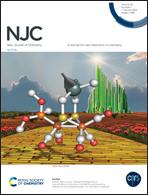Synthesis of hydroxide-enriched cerium-doped oxy-sulfide catalyst for visible light-assisted reduction of Cr(vi)†
Abstract
Semiconductor catalysts are significantly attractive materials for different cutting-edge applications, including the detoxification of toxic pollutants. Herein, a hydroxide-enriched cerium-doped nanoflower-like indium oxy-sulfide catalyst was synthesized via an efficient and simple procedural course with Ce/[Ce + In] = x precursor molar ratios, where x = 0.5, 0.6, and 0.7, and with a fixed thioacetamide molar content in the air atmosphere. All catalyst materials were characterized systematically, and their activities were studied towards the reduction of hazardous hexavalent chromium [Cr(VI)] under visible light illumination. The hydroxide-enriched nanoflower-like Ce–In2(O,S)3 catalyst, with a Ce/[Ce + In] precursor molar ratio at 0.6 designated as S-0.6, exhibited enhanced catalytic activity compared to the rest of the composition and host catalyst material. Its Cr(VI) reducing efficiency was found to be 99.3% within 6 min irradiation time with a rate constant increased by a factor of 5.42 compared to the cerium-free nanoflower catalyst. Hence, the as-synthesized nanoflower-like catalyst is very promising for the detoxification of hazardous Cr(VI) from the source environment.



 Please wait while we load your content...
Please wait while we load your content...